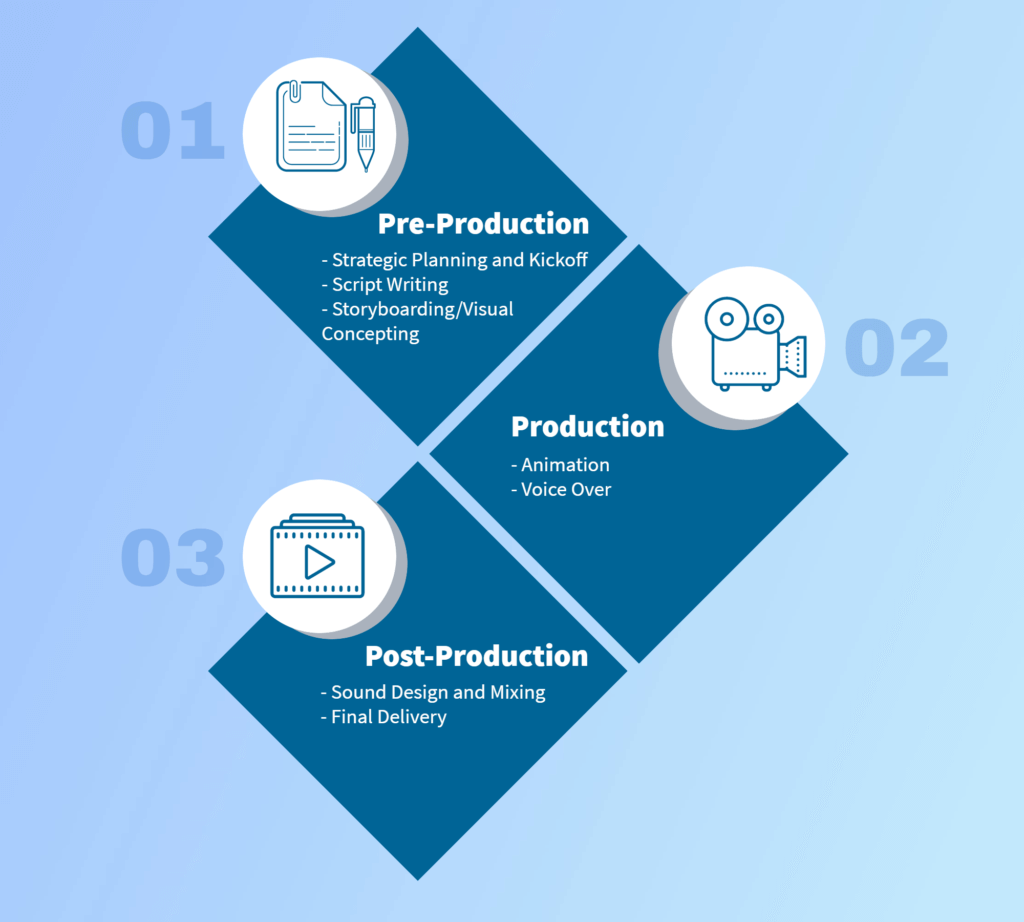Online marketing moves so fast, sometimes it can feel next to impossible to keep up.
As soon as you’ve got your website optimized for SEO and you’ve started blogging regularly, you’ve got to create a vibrant and engaging email strategy. Once you think you’ve got a handle on your email list, suddenly it’s time to tackle all those social media channels. And don’t even get me started on landing pages, lead magnets, and conversion rates.
Of course, these things don’t happen one right after the other – it’s actually worse, because they happen all at once.
With so many marketing priorities already competing for your attention, video marketing can feel like a nuisance – just one more thing demanding your already precious time.
But video isn’t just one more thing. Brands that don’t start harnessing the power of video marketing will miss out on greater results, potential customers, and ultimately, sales.
“Okay, okay,” you’re saying. “I get it. I know how important video marketing is… but I have no clue how to get started.”
Well, if you are like most marketers and businesses, you may not know where to begin. That’s okay.
You are in luck to have this video marketing guide with you. In this guide, we’re going to show you:
- Why Video Marketing?
- The Video Creation Process. (Jump here to find out how you can build your own!)
- How Much You Should Plan To Spend On Video? (Worried about cost? The numbers you want to know are one short click away.)
- How To Use Video Throughout Your Marketing Funnel? (Develop a full-funnel video strategy for more traffic, more leads, and more sales)
- Video Marketing Metrics You Should Measure (ROI alert! ROI junkie, eh? Click here to see how video drives ROI. We dare you.)
Let’s start with the big picture.
Why Video Marketing?
This question may seem elementary, but there’s not a lot of clarity around the importance – or the significance – of video.
Video marketing is powerful, but it’s absolutely not a silver bullet; it’s an amplifier for your business objectives. A video isn’t going to save your business magically – but it will help you see greater results from your marketing efforts.
Let’s take a look at some numbers.
Video Ads: Consumers are 27x more likely to click-through online video ads than standard banner ads. That’s a significantly higher chance that viewers will move one step closer to becoming customers.
Email: Video can increase your CTR by 300% and reduce unsubscribe rates by 75%. This is huge! Email is underrated as a marketing tool, but videos is a great way to turn it into a serious driver of results.
Conversion Rate: 70% of marketers report that video marketing converts better than other types of content. We’ve seen time and again that video can increase conversions by 20-30%!
Bounce Rate: Pages with video see a 34% lower bounce rate than pages without.
Social Media: On social media, video ads are the #1 way that consumers found out about a new brand or a product before purchasing. Also, 46% of consumers watch more video ads on social media than on TV.
These are hard stats, but there are a ton of soft benefits tied to video that can’t be quantified and are nevertheless incredibly valuable – things like a shorter sales cycle, fewer demos, more qualified leads, and clarity of messaging.
Let’s get away from general stats for a moment and look at some specific real-world examples.
- B2B software company CaseComplete saw a 23% increase in conversions within two weeks of launching a homepage explainer video.
- Neil Patel’s CrazyEgg saw a whopping 64% conversion lift, resulting in $24,000 in extra monthly income – all thanks to video.
- Everyone’s familiar with Dropbox – but did you know that they increased sign ups by 10% with an explainer video?
These are world-class companies that have everything pretty refined… and yet they still saw tremendous results from video.
The point we’re trying to make here is that video isn’t a silver bullet – but it also isn’t just a nice-to-have or an add-on to your marketing mix. It has the capacity to drive serious results that are worth every dollar of your investment.
The Video Creation Process: How To Make The Most Of It
All the great production companies out there have developed a killer process with a focus on input – understanding your business objectives, creating a great concept, building a relationship with you – as much as the output.
A standard video creation process can be divided into three phases:
- Pre-production
- Production
- Post-production
1) Pre-production
A) Strategic Planning And Kickoff
The planning and kickoff step is critical to a great video.
This step helps you and your production partner (if you are working with an outsourced team) develop a shared understanding of your business objectives – and the best way to achieve them.
During this step, your in-house or outsourced video production team should focus on having answer to some questions about your business:
- Needs for the video.
- Creative preferences, and the like.
If you have an outsourced team handling your video, they will also :
- Dig into your brand and your industry to make sure they really get what you do.
- Bring it all together in the kickoff meeting, clarify any lingering questions they may have, and make sure all stakeholders are on the same page regarding the project.
B) Script Writing
Script writing is the step that makes or breaks a video. It is the arena where your video partner’s understanding of your business will be tested. As a company, you should be asking yourself the following questions while reading through the script:
- Does it accurately represent your brand?
- Does it speak to the pain points your target audience faces?
However, it’s important not to weigh down your video’s messaging with extra brand features and bloat it up.
A lot of videos go wrong at this point in the production process, when clients aren’t able to relinquish control.
C) Storyboarding/Visual Concepting
This the step where things get really exciting.
Once the script is approved, the next step is to begin with developing storyboards and a visual style for your video. You’ll be able to see your video take shape visually, but at an early enough stage that you’ll be able to provide feedback and help mold that story.
And if you really don’t like where things are headed? Now’s the time to speak up!
2) Production
A) Animation
Once all of the building blocks have been put in place, it’s time to animate.
Here’s the thing about animation -it’s very time-consuming and difficult. An animator has to create all of the elements for each scene in your video, layer them in the right way, and set them in motion – frame by frame by frame.
It can take a full day of work just to animate a few seconds of video. That’s why you want to make sure your share all your feedback this step – even seemingly minor changes can result in days of additional work and that can be really frustrating!
B) Voiceover
There’s no denying it: the voice over is the second most important stage after script writing in your video production process.
Voiceover adds emotion to your video. A voice over professional convey the emotion and can make your audience feel happiness, compassion or excitement over a video. The voice sets the particular mood of the video and adds a human touch to the story.
Other reasons to go with professional voiceover are:
- Credibility: Trust is a key to convert your viewers into customers and a right voiceover help you earn that trust. Using a voice artist who speaks the same language as you audience directly connects with them and increases your chances of conversion.
- Personality: If the voiceover of your video doesn’t match the personality of your brand, it can’t represent you the right way. A personality mismatch can harm you more than doing any good.
On the other hand, A good voice artist can connect immediately with your audience and make them feel confident about your offering.
- Overall quality: The overall quality of your ready to ship video is vital because it represents your brand. Aside from great quality visuals, a nicely recorded video with a voice-over makes the real difference between a high quality and an average or below average video.
3) Post Production
A) Sound Design And Mixing
Sound design acts as the multi-sensory icing on the cake and make your video feel like a cohesive whole.
And that’s it!
As you can see, video production takes a lot of work. So while you may want that marketing video yesterday, it’s worth asking yourself if the deadline you’ve set for final delivery is absolutely critical.
For example, a typical high quality video takes around 8-10 weeks for production.
How Much Should You Plan To Spend On Video?
If there’s one question we get asked more than any other at Explainify, it’s about cost. Everyone wants to know how much they should be spending on video. Which makes sense – you want to know that you’re finding the right balance of quality and value for your organization.
Of course, there are some really compelling reasons to do a great deal of your video marketing production in-house. It’s easy to produce content more frequently, and it’s cost-effective.
But at some point, you may want something high-end. When that happens, you’re going to want to bring in the professionals.
But knowing who to bring on board is difficult. And it doesn’t help that there are so many options to choose from today.
And they all come with radically different price tags: Some may offer to make you a great animated video for under a thousand bucks – while higher-end live-action production teams will only take on projects for $100,000+.
That’s a wide playing field. So how do you choose the right company – and the right price tag?
First of all, you should not settle for cheap, low-quality marketing videos. Like your website, video is a chance to make a great first impression on your potential customers.
If you’re meeting a new client or you’re going on a first date and you ask to meet them at Taco Bell – what are they going to think?
They’re going to think you’re cheap. Taco Bell is great – we love a good Fourth Meal – but it’s the same with video. You can get video on a budget, but it’s not going to represent your brand well – and in fact, it may turn viewers off to your brand.
On the other hand, a perfectly branded, positioned, and produced high quality marketing video can be one of your top armours in your arsenal and actually bring in amazing results.
As far as hard numbers are concerned:
- If you’re just looking for a video – with no regard for quality, branding, or messaging – you could get something reasonable for $3,000-$5,000.
- If you want a video made by extremely innovative animators, dedicated analysts, and project managers who also only work with a limited number of clients so they can focus on you? You’re looking at closer to $15,000-$20,000.
- And if you want an agency-level live-action video, you’re looking at $60,000-$100,000.
Okay, you have an idea about the cost involved in creating a video. Now what?
How To Use Video Throughout Your Marketing Funnel?
This is where things get really interesting.
You invest a lot of time and money in creating a video – and when you – as a CEO or marketer – sink a lot of time and money into something, you want to know:
How to use video throughout your marketing funnel and get the maximum return on that investment?
The way videos have emerged as one of the main conversion drivers, there is no surprise this is one of the most asked questions by founders, marketers, product owners and others.
Let’s use a few images to illustrate why this is valuable.
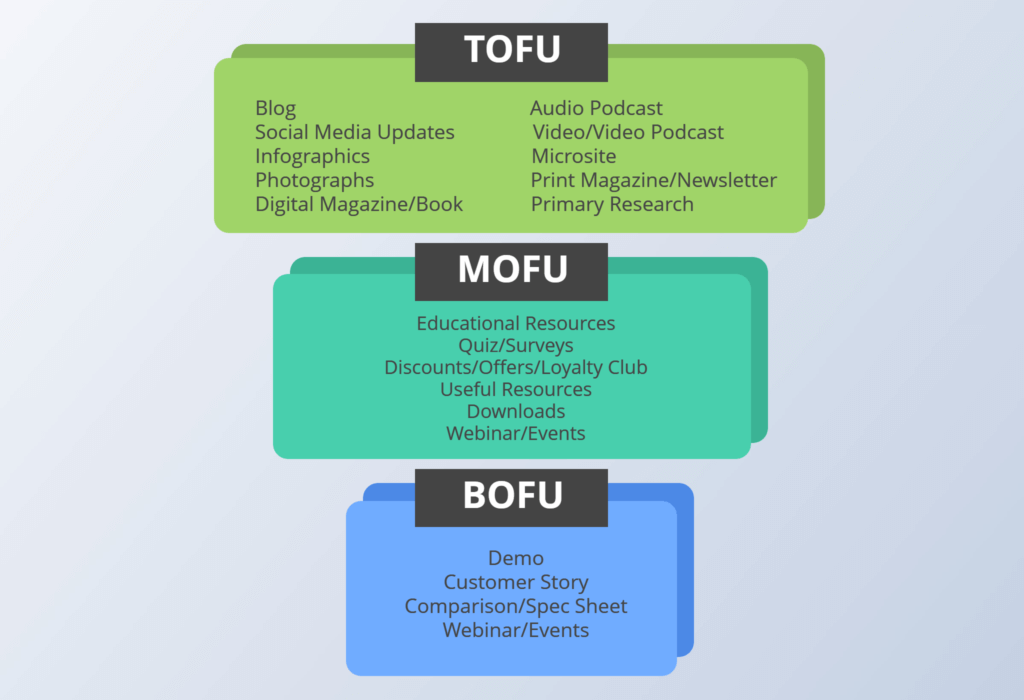
The above image is your marketing funnel at work.
You see, video sits right up at the top of your funnel, enlarges your funnel a bit and attracts more views and conversions. Sounds fantastic, right? It is!
But this is also where video stops in marketing funnel for most brands. Which means you’re still leaving it to your traditional inbound efforts to drive results further down the funnel, and missing a lot of opportunities.
This is a problem.
Video isn’t just for driving awareness. It’s perfect for driving results throughout the Buyer’s Journey – it just needs to be informed by a strong, committed video strategy.
So, let’s get back to answering the original question of how you can use video throughout your marketing funnel?
Now, here is what your marketing funnel with videos looks like:
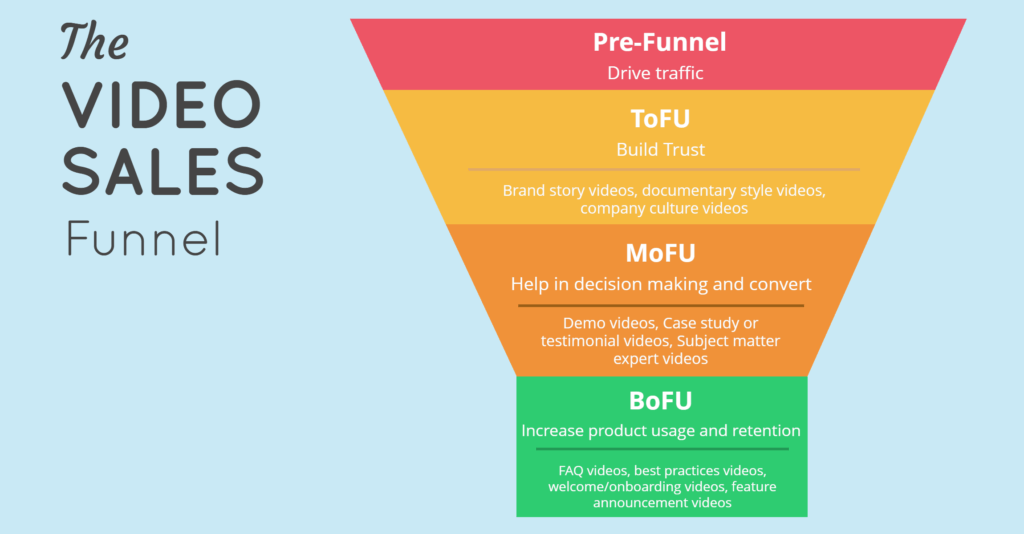
A) Pre-Funnel Video
Let’s start even higher up the funnel than the explainer video. As Neil Patel shows, video ads are incredibly effective at boosting CTRs. So if you need to reach an off-site audience via Facebook or Google ads, video is a great opportunity to drive a new audience to your site or landing page or retarget previous site visitors.
B) Top-of-Funnel Video
Once people have landed on your homepage or landing page, it’s time to hit them with more educational – but still engaging! – video content. These are designed to provide clarity around your unique value proposition and drive people toward a specific conversion point – whether that’s getting on your email list, downloading an ebook/whitepaper, or registering for a webinar.
Oh, and they happen to be great at boosting metrics! You could decrease your bounce rate or double unique visitor counts overnight.
Here are a few different video ideas you can try for your ToFU:
- Company Culture And Values Videos featuring your employees. People prefer to listen to people they can trust or connect with easily.
- Simple Explainer Videos that introduce your product or service.
- Educational Videos with absolutely no selling. Moz’s whiteboard friday is a perfect example of this.
C) Middle-of-Funnel Video
Now you have some ideas how to draw people into the top of your funnel. But we all know that the money gets made in the middle of the funnel. Fortunately, this stage of the buying journey is a goldmine of opportunities for video marketing content as your audience begins to consider their buying options. Here are just a few thoughts:
- A Product Or Service Demo Video: It allows your potential customers to have an in-depth look at your product or software, without requiring your sales team’s time. So, when they do have a conversation with sales, these are much more qualified leads than they were before.
- A Video Case Study Or Testimonial: A great video case study or testimonial can create an intensely human connection between your prospective customers – and your past customers. The social proof of a written case study is great, but capturing your happiest customers on-camera? So much more powerful.
A great example of MoFu video is Zappos. They included videos on their product pages and saw a 30% sales impact because of it. If you knew a video could potentially lift your sales 30%, would you try it? Yeah, we thought you might.
D) Bottom-of-Funnel Video
Now that you’ve engaged your consumers and driven more sales, the bottom of the funnel is a great place to keep your customers engaged and satisfied with ongoing support or education. Here are a couple great examples for this stage of the journey:
- Create FAQ Videos that address your customers’ most common questions – which again saves your staff’s valuable time by fielding common questions.
- A Welcome Video to make your new customers feel at home.
- Product Feature Videos to announce any new feature release and show how to use it.
- Best Practices Videos or an onboarding video walkthrough to teach customers how to use your software or product and get maximum value – and it works wonders in customer retention and churn prevention. Brilliant!
Obviously, there are many ways to help your customers at the bottom of the funnel – these are just a few of the specific ways a full-funnel video marketing strategy can play out.
One thing that is important to know is that not all the videos you publish need same level of attention.
They just need to be made.
You’ve got to develop the holistic video marketing strategy that’s right for your customers – and stick to it.
Defining Your Goals And Metrics To Analyze Results
You’ve worked hard to create a video marketing strategy, and you have a collection of videos to implement it.
While you may have poured your heart and soul into each one, to see whether you are on the right track, it is very important for you to measure which videos are delivering the results you want and which ones need some more attention?
That process starts by knowing how to measure success.
Ideally, before you create a video, you must know:
- Determine the audience you want to reach.
- What you hope to accomplish with it. Limit your focus to one or two main goals.
In doing so, you’ll be better able to identify and choose the right set of metrics to measure the success and tie back to your original objective.
If you aren’t sure, here are six of the most common video metrics and why they matter when it comes to tracking the success of your content.
A) Play Rate
Play rate, aka watch rate, is simply the percentage of people who clicked play button and watched your video.
Play rate is a ratio that calculates the number of plays your video receives divided by its impressions (the number of times your video is seen).
Play Rate = #of time video is played / Total impression count
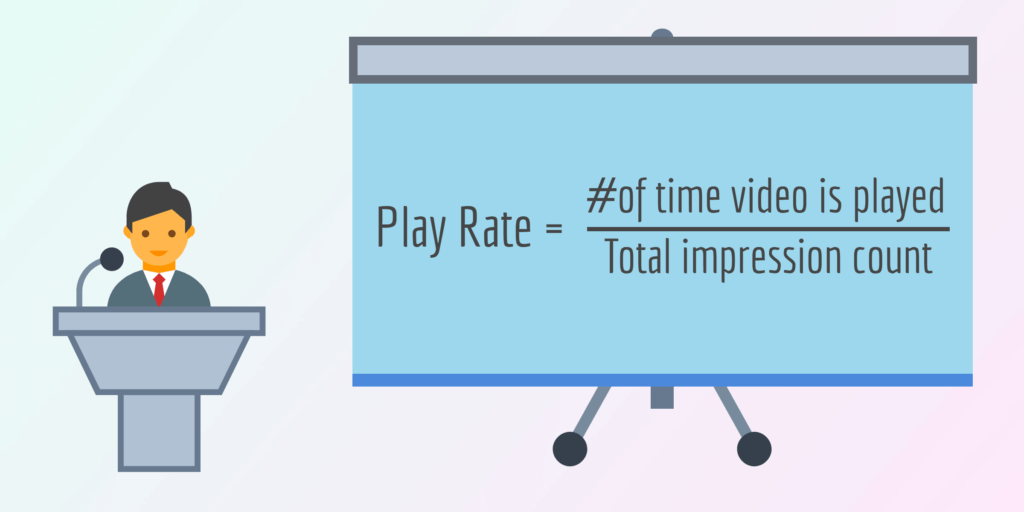
So, if your page (where your video is placed) gets 1000 visitors, of which 150 visitors play the video, your play rate is:
Play Rate = (150/1000)*100 = 15%
Play rate is an indication of your user engagement. It helps you measure how relevant your video content is compared to where it is placed on your website. If your goal is to get your target audience to view your video content, play rate is a helpful metric to track.
If the play rate for your videos is lower than you’d like, it could be because of one of the following reasons:
- Boring video title or caption: your video title is not intriguing enough to encourage people to watch your video.
- Dull video thumbnail.
- Placement of your video: Often placement of a video is the reason of poor performance. If the content of the page where you video is placed and the content of your video is not in-sync, your video will have a poor response.
B) Social Sharing
Social sharing is a measure of your videos acceptance on different social media platforms.
Why is it important?
If someone likes your content enough to share it with their social network, it’s a signal that your message resonated with them.
It is always better to let your audience talk about you instead of talking about yourself. People sharing your videos adds credibility to your content and the brand. Lastly, it creates a snowball effect of word-of-mouth marketing at no cost to you.
If your objective is to build brand awareness, social sharing is one of the best video marketing metrics you can use to gauge success.
C) View Count
While view count is a simple metric to track, use it with caution (and in combination with other metrics). View count is simply the raw number of how many times your video has been viewed.
View Count = #of times a video has been viewed
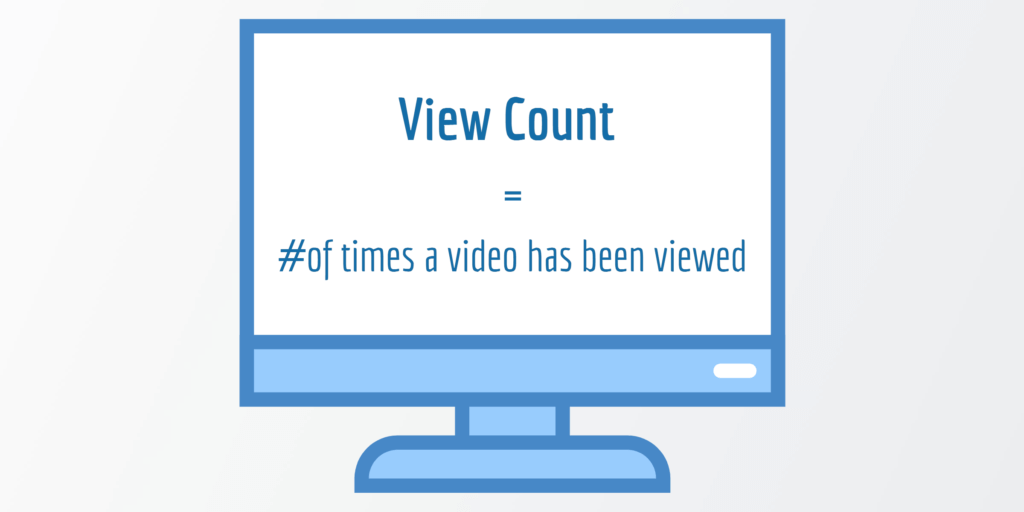
View count is a great way to measure success if awareness and reach are your objectives. But it’s only the first step. Combine view counts with other metrics like social shares and play rates to get a better picture of how well your content is reaching and resonating with your audience.
Be aware, however, that different platforms have different qualifications for what constitutes a “view.”
- Facebook requires that the viewer consumes only three seconds of the video.
- Youtube requires 30 seconds of watch time.
While view count is a good indication of the total reach of your content, we recommend to differentiate it by channel or platform to get the true impact of this metric and to identify the most contributing channel.
If you are looking for ideas to boost view count, following are a few things you can try:
- Share your video content with influencers in your network. If your video is really good, more often than not, these influencers will share it in their network.
- Paid promotion on social platforms where your target audience is most likely to spend their time.
- Share it with your users or customers via email.
- Find the top performing blog posts relevant to the video content and place your video in those posts. Please note, it should fit in the content cadence of the post.
D) Comments And Feedback
Feedback and viewer comments are a bit trickier to measure than other video metrics because they are qualitative, rather than cold, hard numbers.
If your goal is to get a response from and engage with your audience, comments and feedback is a helpful measurement of success.
To boost engagement with your audience, make sure you respond quickly to any comments or questions you receive (whether positive or negative). If you’re not getting regular feedback, try asking your audience what they think of your content.
It requires a bit of thick skin at times, but it’s the fastest way to find out if your audience is connecting with your content.
E) Click Through Rate (CTR)
Click through rate is the percentage of viewers who click on your video’s call to action and go to the next step.
One thing to note here is, not everyone who clicks on call-to-action completes the goal. A good number of people drops off after it because of various reasons.
This metric is your most important metrics to measure the performance of videos distributed outside of your site. For example, If you’re distributing your video content to Facebook or uploading on YouTube to drive traffic back to your site, clickthrough rate is one of your most important metrics.
Tracking click through rate can be difficult with videos across platforms. It is recommended creating a custom URL—so you can track:
- Who is coming to your site after viewing the video.
- Which channel they are coming from.
The levers that play a role in your click through rate are:
- Call-To-Action: Is your CTA promising clear value or benefit?
- Quality of your video: produce high quality video content that leaves viewers wanting to hear more.
F) Conversion Rate
Most video marketing content is created to drive leads or brand awareness. For that reason, conversion rate may be the metric that is most interesting to your organization. It’s simply the number of new leads or customers you acquire from your video content.
The simplest definition of conversion rate is the percentage of video viewers end up completing a set goal. The goal here varies depending on your campaign objectives. The most common video marketing conversion goals are:
- Completing a purchase
- Downloading a resource.
- Signing up for a software trial.
You may need to employ a separate analytics platform like Google Analytics to track and measure conversion rates. Before you do, decide how you will attribute a conversion directly to video content.
- Is it that the video was the last touchpoint before the customer converted?
- Is it a percentage of the overall attribution?
To help boost conversion rates, make sure your content is aligned with what the viewer needs at each stage of the sales funnel. Remember to offer value and solve a problem for the viewer.
Lastly, make sure your video is in the right place on your website to attract attention and drive conversions.
That’s All, Folks…
Phew! Here you are. You made it right to the end.
That means you have learned everything it takes to take your video marketing efforts to the next level and see glaring results.
You see, making your video marketing work requires a lot of effort. But everything revolves around one thing – YOUR VIDEO.
It doesn’t matter how much time and effort you put in; nothing will work if your video doesn’t resonate with your audience.
Now, it’s over to you!
How are you going to get started? Don’t forget to let us know.
And if you are looking for a trusted video partner to help you create a video that speaks with your audience – look no further. Get in touch with us today!


